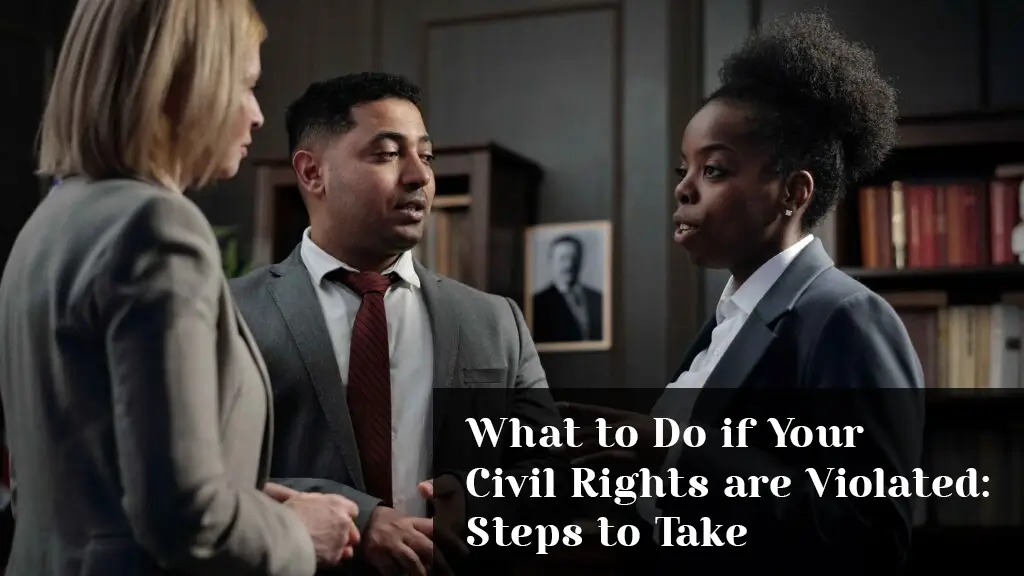Introduction
Civil rights are the basic rights and freedoms that every person in the United States has. These rights protect you from unfair treatment and ensure that you are treated equally under the law. Unfortunately, sometimes these rights can be violated. If you feel that your civil rights have been taken away or ignored, it is important to know what steps to take. This blog will guide you through what to do if civil rights are violated, including how to file a civil rights lawsuit in the USA.

Understanding Civil Rights
Before we dive into the steps, let’s talk about what civil rights are. Civil rights include the right to free speech, the right to vote, and the right to equal treatment in public places. They are protected by laws at both the state and federal levels. When someone breaks these laws, it can lead to a violation of your civil rights.
Common examples of civil rights violations include discrimination based on race, gender, or disability. It can also happen if someone is unfairly treated by the police or denied their rights in a public space. Understanding these rights is the first step in knowing how to protect yourself.
Step 1: Recognize the Violation
The first thing you need to do is recognize that your civil rights have been violated. This can sometimes be tricky. You might feel that something is wrong, but you may not know if it is a legal issue. Here are some signs that your civil rights might have been violated:
- You were treated unfairly because of your race, gender, or another characteristic.
- You were denied service in a public place.
- You were arrested without a good reason.
- You were punished for speaking out or expressing your opinion.
If you notice any of these signs, it is important to take action.
Step 2: Document Everything
Once you recognize that your civil rights have been violated, the next step is to document everything. This means writing down what happened when it happened, and who was involved. Be as detailed as possible. If there are any witnesses, ask them to write down what they saw as well.
Taking pictures can also be helpful. For example, if you were treated unfairly in a public place, take photos of the location and any signs that may be relevant. Keeping a record of everything will help you later if you decide to take legal action.

Step 3: Report the Violation
After documenting the incident, the next step is to report the violation. Depending on the situation, there are different places to report civil rights violations. If it involves a police officer, you can file a complaint with the police department. If it is about discrimination in a business, you can report it to the Equal Employment Opportunity Commission (EEOC) or your state’s human rights agency.
When making a report, be clear and concise. Share all the details you documented. This is important because it helps the authorities understand your situation and take appropriate action.
Step 4: Seek Legal Advice
If you feel that your civil rights have been seriously violated, it may be time to seek legal advice. An estate planning lawyer or a civil rights attorney can help you understand your options. They can explain the laws that protect your rights and guide you through the process of filing a lawsuit if necessary.
When looking for a lawyer, make sure to choose someone who specializes in civil rights cases. They will have the experience and knowledge needed to help you.
Step 5: How to File a Civil Rights Lawsuit in the USA
If you decide to take legal action, you may want to know how to file a civil rights lawsuit in the USA. Here are some basic steps to follow:
- Consult Your Lawyer: Before filing a lawsuit, discuss your case with your lawyer. They will help you determine if you have a strong case and what type of lawsuit to file.
- Gather Evidence: Work with your lawyer to gather all the evidence you collected. This includes any documents, photos, and witness statements.
- File the Complaint: Your lawyer will help you draft and file a complaint in the appropriate court. This document will explain your case and what you are asking for.
- Serve the Defendant: After filing, the defendant (the person or organization you are suing) must be notified. This is called “serving” the defendant.
- Prepare for Court: If the case goes to court, your lawyer will help you prepare. This includes gathering more evidence and preparing to present your case.
- Attend the Hearing: Finally, you will attend the court hearing. Your lawyer will represent you and present your case to the judge.
Conclusion
Dealing with a civil rights violation can be overwhelming and stressful. However, knowing what to do can help you feel more in control. Remember to recognize the violation, document everything, report it, seek legal advice, and understand how to file a civil rights lawsuit in the USA if necessary. By following these steps, you can take action to protect your rights and ensure that justice is served.

